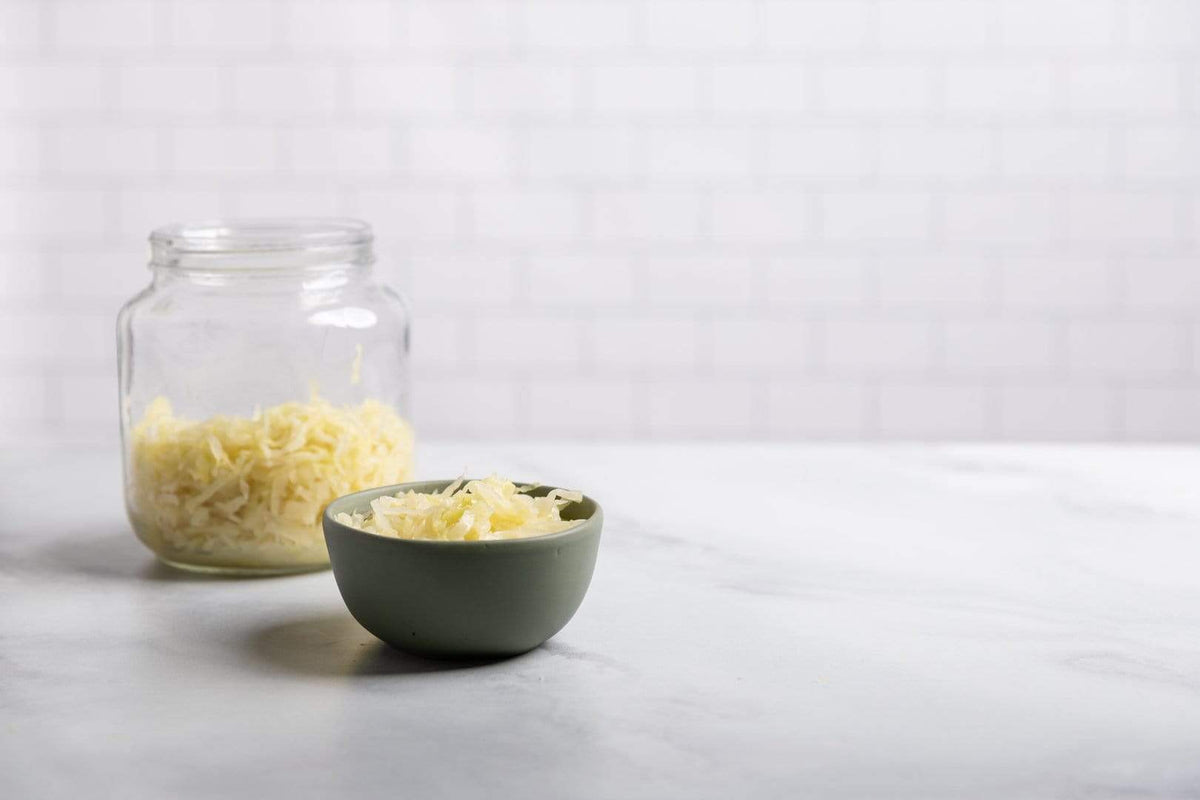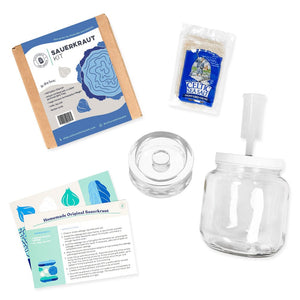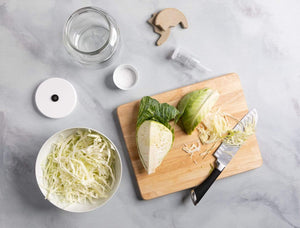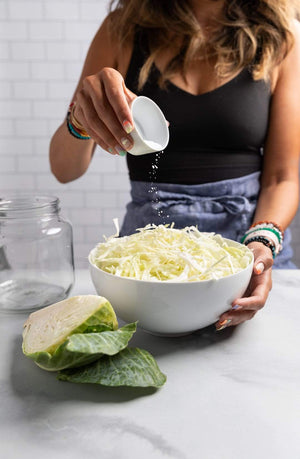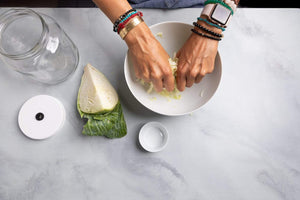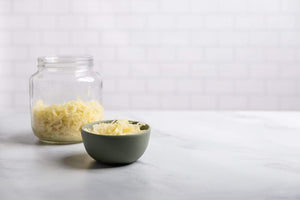
Once you get the hang of it, fermenting vegetables is a simple process.
And, while it does not require particularly specialized fermentation equipment, there are certainly some fermentation kits that can certainly make preparing and fermenting even easier!
We want to help you choose the suitable fermentation container for your needs. Click here to download our Lacto-Fermentation Guide book which provide a lot of information on different types of fermentation containers, as well as reviews and comparisons of the top products on the market.
Fermentation Supplies Needed To Prepare Vegetables
1. Fermentation Equipment: A Quality Knife or Food Processor
There are a few different ways to prepare your vegetables for fermenting. Whether you are grating, chopping, or slicing, a good quality knife or food processor is key.
2. Fermentation Equipment: Pounding Tool
If you're fermenting sauerkraut or other vegetables that ferment in their own juices, you will need some sort of pounding tool to help break apart the vegetables and compress them together in the fermenting vessel. The Pickle Packer works well for this as it is dual sided to work with multiple sized jars.


FERMENTATION JARS & CONTAINERS
There is no shortage of options when it comes to choosing a container for fermenting your vegetables, fruits, or condiments.
Fermenting vessels range from wide-mouth glass jars to ceramic crocks. What you use ultimately depends on what vegetable you're fermenting and your personal preferences, but here are some things to keep in mind when choosing a container.
Glass Containers: Easy to Find
Glass is one of the best options for fermenting vegetables because it doesn’t scratch easily, nor does it contain chemicals such as BPA. Glass containers such as canning jars are relatively easy and inexpensive to obtain.
Our Sauerkraut Kit and Homemade Kimchi Kit come with quart-sized glass canning jars. For larger batches, Fermented Vegetable Master glass crocks are available in half-gallon and gallon sizes.
Sauerkraut Making Kits
To those who love gluten-free foods, click to know the answer "Is kimchi gluten free?".
Mortier Pilon's Vegetable Fermenting Crock is another good glass option. It's a bit sleeker than your traditional fermenting crock and uses a specially designed lid with a water barrier to help protect vegetable ferments against unwanted bacteria.


Ceramic Containers: Good for Large Batches
Ceramic fermentation crocks are fairly common and are a good choice for making large batches of fermented vegetables. German fermenting crocks range from 5-20 liters in size and you can often find them at local farm supply stores or from local potters.
Porcelain Containers: Generally Safe
Food-grade porcelain is generally safe for fermenting vegetables. Be sure to avoid porcelain pieces such as vases or decorative pottery that are not food grade.
Why You Should Avoid Plastic Containers As Fermenting Jars?
Although technically plastic can be used for fermentation, we do not recommend it for several reasons.
First, plastic can be damaged, and scratches in the plastic can harbor foreign bacteria. Second, plastic (even food-grade plastic) often contains undesirable chemicals that can affect the vegetables.
LIDS AND AIRLOCKS FOR FERMENTING VEGETABLES
How you cover your fermenting vegetables can be the difference between a perfect batch of crunchy pickles and moldy cucumbers. An ideal cover will keep oxygen away from your vegetables but still allow the gases produced from lacto-fermentation to escape.
Whether you decide to use a cloth cover, tight lid, or lid with an airlock is up to you, though some options work better than others.
Lid With Airlock: The Popular Choice For Fermentation Supplies
Using a jar with an airlock in the lid is a popular option for fermenting vegetables, and many designs are available.
For use with wide-mouth canning jars, Pickles Pipes and the Perfect Pickler are great choices! Wide-mouth canning jars come in a range of sizes, from half-pint to half-gallon. The Pickle Pipe attaches snugly under the ring of the jar.

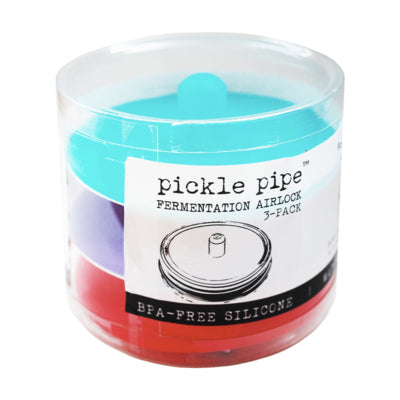
For larger batches, try our half-gallon or gallon-size Fermented Vegetable Master. These glass jars come complete with airlock lid, storage lid, and ceramic fermentation weights.
Fermenting vegetables with an airlock lid greatly reduces the chance of mold or kahm yeast formation, no burping required!
Tight Lids: Less Chance of Mold, More Burping Needed
Using a canning jar or other glass jar with its lid tightly closed is another option when fermenting vegetables.
The advantage to using a tightly-sealed lid is that exposure to oxygen is reduced, so the chance of mold or kahm yeast forming on the surface is reduced.
A disadvantage is that the jar requires more attention. When using a tight lid, you'll need to burp the fermenting jar daily. Understanding how fermentation works can help explain why carbon dioxide can accumulate during the process. To prevent overflow or explosions caused by excess pressure, it's important to burp the jar periodically while fermenting vegetables.
Cloth Covers: Sufficient But May Lead to Mold
For smaller jars, a paper coffee filter secured with a tight rubber band or canning lid ring works well to keep pests out and allow fermentation gases to escape.
For small or large containers, a tight-weave dish towel or butter muslin, secured with a rubber band is sufficient as well.
One advantage of using a cloth cover is that it is easy to peek in or sneak a taste of the fermenting vegetables at any point.
The disadvantage is that mold or kahm yeast forms more often on the surface of the vegetables. This surface formation is usually harmless and can be removed and discarded. Learn more about kahm yeast and how it can affect fermenting vegetables.
FERMENTATION WEIGHTS
Even when using a lid with airlock, keeping the vegetables submerged under the brine during fermentation is important to help reduce exposure to oxygen.
To keep your vegetables submerged, you can use any object that is clean and free of glues or other chemical coatings that might contaminate your fermenting veggies.
Objects such as fermentation weights, glass jars, or plastic bags filled with water work well. You can learn more about how to keep vegetables submerged during fermentation in our tutorial.
THE TAKEAWAYS
Between pounders, containers, and airlocks, you have a lot of options when it comes to fermentation equipment. If you're just starting out fermenting, choosing kit can help simplify the process.
- Perfect Pickler Vegetable Fermenting Kit
- Classic Sauerkraut Kit
- Homemade Kimchi Kit
- Fermented Vegetable Master
Ultimately the choice is up to you. Try out a few methods to determine which supplies work best for you! Happy Fermenting!

















